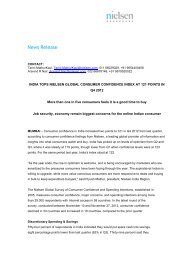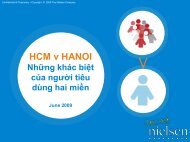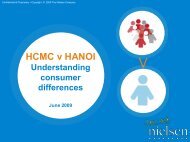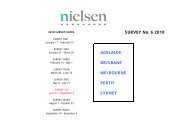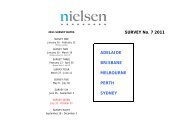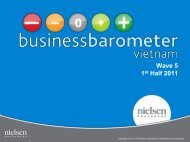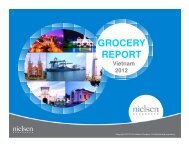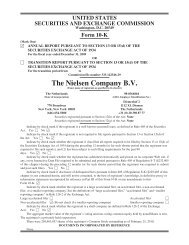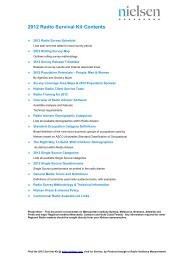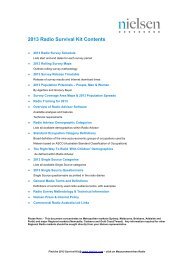2010 Radio Ratings Survival Kit - Nielsen
2010 Radio Ratings Survival Kit - Nielsen
2010 Radio Ratings Survival Kit - Nielsen
Create successful ePaper yourself
Turn your PDF publications into a flip-book with our unique Google optimized e-Paper software.
Over all cities surveyed, an average of 83% of diaries that are placed are returned useable and entered into the computer to comprise the sample.<br />
The <strong>Nielsen</strong> Company - <strong>2010</strong> <strong>Radio</strong> <strong>Survival</strong> <strong>Kit</strong>.<br />
Page 4 of 5<br />
Whilst the survey method used is loosely called the "diary method", it should more correctly be called the "diary/personal interview method" since diaries are placed and collected<br />
personally in contrast to diary methods used in other parts of the world where diaries are posted to respondents.<br />
7. DATA PREPARATION<br />
After completed diaries are returned to our Sydney office, they are subject to editing by a separate staff of experienced editors, quite independent of field interviewers or data<br />
preparation personnel. In-office editing procedures aim to check the consistency of diary records and to validate the consistency of station identification.<br />
8. COMPUTING<br />
After the in-office editing process, all records are transferred directly into the computer using equipment in our Sydney office. All batch computer runs for reports are conducted on our<br />
in-house computer in Sydney.<br />
9. RAISING FACTORS<br />
Population details for each market are entered into the computer at the start of each year and as each survey is processed, details of the sample composition are also entered into the<br />
computer. By dividing each population figure by its corresponding sample size, the computer calculates raising factors for each age/sex group and for each grocery buyer group. This<br />
means that each person is given a separate "weight" in order to ensure his or her true importance in all projected results as shown in this report. Thus if one particular group is undersampled,<br />
each person in it is given a higher weighting: or if a group is over-sampled, each person is given a lower weighting. All projected results in this report are shown to the<br />
nearest 1,000 persons in Sydney, Melbourne, Brisbane, Adelaide, Perth and Newcastle (nearest 100 persons elsewhere).<br />
10. SPECIFICATIONS<br />
The specifications of this survey meet the requirements of an Industry Committee comprising representatives of Commercial <strong>Radio</strong> Australia Ltd and by invitation, the Australian<br />
Broadcasting Corporation.<br />
<strong>Radio</strong> surveys are audited by an independent auditor (appointed by Commercial <strong>Radio</strong> Australia.) who has free and unrestricted access to all field documents and office procedures.<br />
Details of the Auditor's reports are available upon request to Commercial <strong>Radio</strong> Australia Ltd.<br />
11. ERRORS, OMISSIONS etc.<br />
Each report is issued subject to any errors and omissions. Although every reasonable precaution has been taken to present accurate information, it is possible that there may be some<br />
inaccuracies, such as faulty designation of programmes. In these cases-<br />
As listeners provide the information about the stations to which they listen and the times they listen, and<br />
As the stations provide details of the programmes and their days and times of broadcast, a programme incorrectly listed has no bearing on the validity of the figures in the report.



